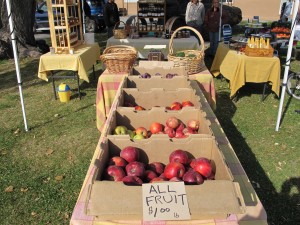Rural Communities and the Funding Crunch

Molly Messick / StateImpact Idaho
Fairfield's downtown farmer's market is organized by a couple who say they needed a new source of income after one of them lost a job.
StateImpact’s recent story about Fairfield, in Camas County, described the about-face the town has suffered due to the recession. What it didn’t talk about is the town’s water system. In short, it’s not great. Right now, a water pressure problem allows bacteria to build up, clogging meters, pipes and distribution lines. That can have some unhappy consequences, according to Carleen Herring, vice president of Region IV Development Association.
“They get these little globs of a biofilm, which, for lack of a better phrase, is slime,” she said. “So if you open your faucet in the dark of night to get yourself a glass of water, you’d better let it run for a few minutes or you’re going to have a glass full of ooze.”
Herring is working with the town to secure the grant and loan money it needs to get a new well, tank, pumps and other equipment. Unfortunately, Fairfield is attempting to fix its water problem at a moment when funding is tight. Due to budget cuts, there is simply less federal and state community development money to go around. Often, those dollars are key in allowing rural communities to pursue the kinds of public infrastructure projects that might help them grow. That means not just water and sewer projects, but also things like improvements to local hospitals, fire stations and community centers.
How much has that funding decreased since the start of the recession? Here are some key numbers:
- In Idaho, the amount received through the Department of Housing and Urban Development’s Community Development Block Grant program that targets small cities and towns has gone down by $1 million.
- According to the Idaho Department of Commerce, the allocation for the state-funded Rural Community Block Grant program currently stands at $400,000. That’s down from $3 million.
- U.S. Department of Agriculture Rural Development increased its combined loan and grant funding in 2009 and 2010, thanks to federal stimulus funds. It provided roughly $35 million in the state in each of those two years. In 2011, however, Idaho’s funding fell to just under $16 million, its lowest level since 2003. That’s due to the expiration of federal stimulus funds, and because some Idaho communities failed to pass bonds that would have allowed them to access federal loan dollars.
Last year, when Fairfield first applied for state-administered Housing and Urban Development grant funds for its water project, it was turned down. For former mayor David Hanks, that was an enormous disappointment, and a bad sign for his town. “Let’s say we can only supply two more new businesses and eleven more homes with water until we either drill a new well and put new supply lines in,” he said. “We really can’t grow as a community.”
Hanks said he feels state leaders have turned a blind eye to the problems of rural communities since the start of the recession, focusing on the needs of the state’s population centers instead. The Idaho Department of Commerce disputes that. “The entire budget of the Commerce Department has been cut, as it has in other agencies clear across the state,” said Business Development Manager Randy Shroll. He said that, yes, some communities are finding themselves waiting for funding, but those delays shouldn’t be substantial. “We’re going to continue to plug away and help these communities in every way we can,” he said.
Region IV Development Association’s Herring said it’s the loss of grant dollars (as opposed to loan funding) that is particularly hard for small communities. She often works with towns like Fairfield that are home to only few hundred people, and she said places of that size generally have a hard time absorbing the high cost of large-scale infrastructure projects. “If you’ve got a small town that has maybe 200 people hooked up to a water system,” she said, “and they need to spend a million dollars for a new water tank and new well, that’s a huge hit to those 200 folks.”
So far, the renewed effort to improve Fairfield’s water system is going well. The town needs about $2.5 million, and Herring is optimistic. It has $2 million covered, thanks to loan and grant commitments from U.S. Department of Agriculture Rural Development. It’s the remaining $500 thousand that is in question. Herring is in the process of reapplying for federal block grant funds, and she hopes Fairfield will get good news when the decision comes down next spring.
If it doesn’t, Herring said, the town will probably have to settle for less than optimal improvements. “The most likely component that will be cut will be the tank,” she said. “We’ll just go as far as we can with the USDA funds. And that’s generally what these communities have to do. If one of their funding sources doesn’t come through, they start slashing project components and just build what they can with the dollars they do have.”


